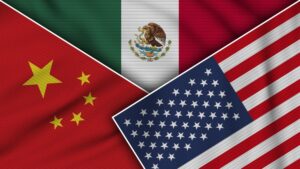Vance and Lighthizer: Continuing Tariffs on China Is a Step Toward Helping US Workers

Earlier this week, J.D. Vance accepted the nomination to be Donald Trump’s running mate in the 2024 presidential election. The following is an excerpt from a column he co-authored with former USTR Robert Lighthizer in 2021.
While public sector unions have thrived because the public sector itself has grown, private sector unions have been annihilated by a bipartisan force: globalization. While much of our political debate over organized labor has focused on the effects of Right to Work and related laws, the evidence suggests that these types of reforms have minimal effect. Wisconsin, for instance, is a Right to Work state and Ohio is not, yet workers in Ohio have not fared obviously better (or worse) than those of Wisconsin.
That’s because on a national scale, the jobs that supported a good union wage have become less common or disappeared altogether. Economist David Autor has found that from 1999 to 2011, 2.5 million good manufacturing jobs were lost to import competition from China alone. We’ve also lost millions of jobs to other countries like Mexico. Combined, the effects of globalization have hollowed out America’s industrial core.
These policies have made our country far less self-sufficient economically. Just remember last year, when the Chinese Communist Party threatened America with a loss of critical pharmaceutical ingredients at the height of a global pandemic. But they’ve also destroyed millions of middle-class livelihoods. As Autor also found, when the manufacturing jobs moved out, a host of social problems moved in: family divorce and breakdown, child abuse and neglect and opioid addiction. Ohio suffered more than most states from the decline of manufacturing jobs.
Some blame the disappearance of these manufacturing jobs on unions themselves. And while there are undoubtedly examples of inflexible unions that made it harder for their companies to keep factories in America, many countries have far higher union participation rates but suffered much less of a decline in manufacturing employment.
Far more important than any individual union was the cheap labor overseas and the fact that our government did nothing to stop U.S. companies from exploiting it. Indeed, policymakers often encouraged offshoring through bad trade deals and tax policy.
09/09/2021 | J.D. Vance & Robert Lighthizer | Akron Beacon Journal
Navigating Protectionism’s Trade Barriers
There was a glorious time not long ago when corporate decision makers and small businesses had a clear understanding of how America’s two main political parties differed on economic and trade issues. Republicans were the champions of free market and open trade, small government and limited regulation. Conversely, Democrats were fighting to protect domestic industry from undue foreign competition and to protect consumers from malpractice through stronger regulatory checks and balances.
One could choose to agree or disagree with either position, but the positions were clear and, more importantly, they were firm. In less than a decade, a seismic shift has occurred that not only creates ambiguity over economic policy but also narrows the distinction in party platform on matters of trade. The choice is no longer between open trade and trade protectionism, but rather between trade protectionism and … more trade protectionism.
Indeed, since the initiation of Washington’s trade war with China, U.S. consumers have been forced to dole out about $215 billion in extra costs associated with the duties importers have to pay. What started out as a strategic move by the Trump administration to renegotiate the terms of NAFTA quickly morphed into a series of protectionist escapades, including a 25% tariff on almost all goods coming in from China and a comparable tariff on imports of steel and aluminum.
These practices were maintained by the Biden Administration. In addition, Congress allowed the Generalized System of Preferences (GSP) – a program that offered preferential duty to developing nations – to expire during the final days of the Trump administration. Since then, there has been tepid impetus by members of Congress on either side of the aisle to resurrect the program. In addition, a host of non-tariff barriers have been imposed by the current government in the form of various safety checks, domestic production quotas and barriers to entry in the U.S. market. Not only did the Biden administration choose not to reverse the Section 301 tariffs against China, but recently it doubled down on them by multiplying the rate as much as four times on some items and allowing pre-existing exceptions to the tariffs to expire.
07/10/2024 | Jill Hurley | Livingston
Navigating Geopolitical Challenges: Mexico as a Key Factor in U.S.-China Trade
The global supply chain is an ever-changing landscape, always looking to implement the most efficient and effective means to ensure products are sourced, manufactured and delivered as quickly and safely as possible. Many companies have relied on specific regions for sourcing and manufacturing over the decades, but a new survey indicates that the interest is at unprecedented levels. According to a QIMA survey, the appeal of shortened supply chains has reached a record high, with more than 64% of businesses globally expressing interest in nearshoring and reshoring strategies for 2024.
In 2023, a significant shift was already underway, with more than half of the surveyed participants reporting increased purchases from domestic and regional suppliers. This trend, driven by a desire to reduce disruptions, ensure greater supply chain resilience and underscore ESG initiatives, is set to gain even more momentum in the coming year.
While the United States has long relied on Chinese imports driven primarily by cost considerations, access to a large manufacturing base, the wide range of products available to manufacture/develop in the region, geopolitical tensions and trade uncertainties have prompted a reevaluation of this dependency, leading to a significant shift in supply chain dynamics. Even more so, the COVID-19 pandemic exposed the massive dependency the West had on China and other South Eastern Asia countries.
Concerns grow
Concerns over trade disputes, tariffs and geopolitical risks continue to intensify, especially as the U.S. enters another high-profile election year. U.S.-based businesses continue to seek alternative sourcing destinations to diversify their supply chains and mitigate potential disruptions.
While some may view nearshoring and reshoring as protectionist measures, they present real opportunities to foster additional global economic growth, job creation and sustainability initiatives. Mexico has emerged as a preferred destination for these nearshoring and reshoring efforts, especially for U.S. companies seeking to optimize their supply chains.
In fact, the U.S. Commerce Department released data that reinforced Mexico as the top source for goods to the U.S., ahead of China for the first time in two decades.
07/11/2024 | Ivan Hernandez | Supply Chain Management Review
Safeguards Without Compensation — A New Normal?
Mexico’s push for exclusion from the United States’ solar safeguard measure, which jumped into the news this week, raises a point of potential interest for the IELP [International Economic Law and Policy] Blog audience.
The escape clause / efficient breach theory of safeguards holds that a WTO Member can temporarily retract a trade concession, hiking tariffs and thereby providing an opportunity for orderly adjustment by its domestic producers, while preserving the balance of concessions by compensating affected trading partners during the time the tariff umbrella is up. There is a general 3-year grace period for compensation, but that has long since lapsed in the case of the solar safeguard measure which has been in place for nearly 7 years without compensation being provided to anyone. The silence on this point, both from governments and from trade geeks, has been rather odd.
While all WTO members have been entitled to compensation for their trade losses resulting from the solar safeguard measure since Day 1 of Year 4, Mexico – by virtue of the NAFTA and the USMCA – has been entitled to compensation (or else exclusion from the measure) since Day 1 of Year 1.
According to the news reports, Mexico is currently seeking not compensation but exclusion from the measure … consistent with instructions President Biden included in his February 2022 proclamation extending the measure for four additional years. The issue has taken on increased importance with the measure’s recently-restored coverage of bifacial solar modules, which dominate Mexico’s solar exports to the United States. Suddenly, the measure has, in respect of intra-North American trade, a more painful bite.
If an exclusion is not quickly implemented, the compensation which Mexico could demand (and lawfully help itself to) would not be trivial. During the four-year reference period prior to the safeguard measure, 2013-2017, Mexico accounted for roughly 10% of U.S. solar panel imports. During the safeguard measure’s time in force, Mexico’s share of U.S. imports has fallen dramatically. Switching to absolute numbers and looking at the last calendar year (2023), if Mexico had been supplying 10% of U.S. imports (as during the reference period), the value of its solar exports would have been about $1.4 billion. Actual Mexico-to-U.S. shipments in 2023 were roughly $400 million. So the current run rate, in regard to Mexico’s trade losses as traditionally measured, is about $1 billion/year. Suspension of concessions on south-bound trade flows of that magnitude could be expected to cause a bit of a stir.
07/17/2024 | John Magnus | International Economic Law and Policy Blog
WITA – We put the community in trade community.
Information about upcoming WITA and trade community events




